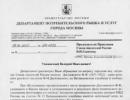What is the longest parallel on the map of the hemispheres? What is the name of this line? And what is the shortest parallel? Degree grid of the globe Questions and tasks
Almost all of you have paid attention to the "mysterious lines" on maps and globes representing latitude (parallels) and longitude (meridians). They form a grid system of coordinates by which any place on Earth can be precisely defined - and there is nothing mysterious or complicated about it. Parallels and meridians are imaginary lines on the surface of the Earth, and latitude and longitude are their coordinates that determine the position of points on the surface of the Earth. Any point on Earth is the intersection of a parallel and a meridian with coordinates of latitude and longitude. This can be most clearly studied with the help of a globe, where these lines are indicated.
But first, everything is in order. Two places on the Earth are determined by its rotation around its own axis - these are North and South Poles. On globes, the pivot is the axis. The North Pole is located in the Arctic Ocean, which is covered sea ice, and researchers in the old days reached this pole on a sleigh with dogs (it is officially believed that the North Pole was discovered in 1909 by the American Robert Peri). However, since the ice moves slowly, the North Pole is not an actual, but rather a mathematical entity. The South Pole, on the other side of the planet, has a permanent physical location on the continent of Antarctica, which was also discovered by land explorers (Norwegian expedition led by Roald Amundsen in 1911).
 Halfway between the poles at the "waist" of the Earth is a large circle line, which is represented on the globe as a seam: the junction of the northern and southern hemispheres; this circle line is called - equator. The equator is a line of latitude with a value of zero (0°). Parallel to the equator above and below it are other lines of the circle - these are other latitudes of the Earth. Each latitude has a numerical value, and the scale of these values is measured not in kilometers, but in degrees north and south of the equator to the poles. The poles have meanings: North +90°, and South -90°. Latitudes above the equator are called northern latitudes, and below the equator southern latitudes. Lines with degrees of latitude are called parallels, since they run parallel to the Equator and are parallel to each other. If parallels are measured in kilometers, then the lengths of different parallels will be different - they increase when approaching the equator and decrease towards the poles. All points of the same parallel have the same latitude, but different longitudes (the description of longitude is just below). The distance between two parallels that differ by 1° is 111.11 km. On the globe, as well as on many maps, the distance (interval) from a latitude to another latitude is usually 15° (that's about 1,666 km). In figure No. 1, the interval is 10 ° (this is approximately 1,111 km). Equator is the most long parallel, its length is 40,075.7 km.
Halfway between the poles at the "waist" of the Earth is a large circle line, which is represented on the globe as a seam: the junction of the northern and southern hemispheres; this circle line is called - equator. The equator is a line of latitude with a value of zero (0°). Parallel to the equator above and below it are other lines of the circle - these are other latitudes of the Earth. Each latitude has a numerical value, and the scale of these values is measured not in kilometers, but in degrees north and south of the equator to the poles. The poles have meanings: North +90°, and South -90°. Latitudes above the equator are called northern latitudes, and below the equator southern latitudes. Lines with degrees of latitude are called parallels, since they run parallel to the Equator and are parallel to each other. If parallels are measured in kilometers, then the lengths of different parallels will be different - they increase when approaching the equator and decrease towards the poles. All points of the same parallel have the same latitude, but different longitudes (the description of longitude is just below). The distance between two parallels that differ by 1° is 111.11 km. On the globe, as well as on many maps, the distance (interval) from a latitude to another latitude is usually 15° (that's about 1,666 km). In figure No. 1, the interval is 10 ° (this is approximately 1,111 km). Equator is the most long parallel, its length is 40,075.7 km.
A) 1 B) 2 C) 3 D) 4
2. What are the coordinates of the easternmost point in Africa?
A) 16° S 3° E
B) 10°N 51°E
B) 51°N 11 E
D) 16°N 3°W
3. What type of climate is indicated on the map by hatching?
A) subequatorial
B) Tropical desert
B) tropical humid
D) Equatorial
4. Which country is indicated on the map by a contour line?
A) Congo
B) Egypt
B) Somalia
D) Ethiopia
5. What conclusion about the climate of Africa is fashionable to draw on the basis of the fact that the mainland is crossed by the equator and both tropics?
A) Africa receives a large amount of heat all year round.
B) Africa is in the zone of the trade winds
C) Africa has tropical and equatorial climatic zones.
D) All of the above
6. What researcher made a great contribution to the study of Africa - discovered the Victoria Falls, studied Lake Nyasa?
A) Vasco da Gama B) V.V. Juncker C) D. Livingston D) N.I. Vavilov
7. What is located north of the East African Plateau?
A) Cape Mountains B) Dragon Mountains C) Mount Kilimanjaro D) Ethiopian Highlands
8. There are more in South and East Africa than in North:
A) Oil B) Phosphorites C) Uranium ores D) Gas
9. In the subequatorial zone of the Northern Hemisphere in Africa, precipitation falls:
A) Throughout the year B) in summer C) in winter D) in September and March
10. In tropical latitudes South Africa more rainfall occurs along the east coast than along the west coast, because there:
A) moist equatorial air masses act
B) a cold current cools the air and contributes to the formation of precipitation
C) monsoons in the southern hemisphere during the summer
D) The trade winds bring humid air from the Indian Ocean.
11. The most full-flowing river in Africa, full-flowing throughout the year, does not form a delta, these are:
A) Nile B) Congo C) Zambezi D) Niger
12. What is the deepest lake in Africa?
A) Victoria B) Nyasa C) Tanganyika D) Chad
13. What plant or animal is not typical for the savanna zone?
A) Hippopotamus B) Gorilla C) Acacia D) Baobab
14. What peoples live in northern Africa?
A) Arab peoples B) Bushmen C) Negroids D) Pygmies
15. Which country in Africa is the largest in terms of population?
A) Egypt
B) South Africa
B) Algeria
D) Nigeria
define geographical latitude Paris, Mexico City and the Panama Canal.
3. On the map of the hemispheres, determine the geographical coordinates of St. Petersburg, Cape Town and Lake Chad.
4. Based on the physical map of Ukraine, determine the geographical coordinates of the regional center of your region. (Donetsk)
5. Based on geographical coordinates, determine the objects on the map of the hemispheres:
a) the highest waterfall in the world 6 N, 61 W;
b) an island that has several names: Rapa Nui, Vaigu, but on the map it is designated under a different name - 27 N, 109 W; + c) an object that in 1856. opened by American traveler David Livingston-18 N, 26 E, d.
The points of intersection of the earth's axis with the surface of the globe are called poles (North and South). The Earth rotates once around this axis in 24 hours.
A circle is drawn at the same distance from the poles, which is called the equator.
Parallel - lines conventionally drawn on the surface of the Earth parallel to the equator. The parallels on the map and the globe are directed to the west and east. They are not equal in length. The longest parallel is the equator. The equator is an imaginary line on the earth's surface, obtained by mentally dissecting an ellipsoid into two equal parts (the Northern and Southern hemispheres). With such a dissection, all points of the equator are equidistant from the poles. The plane of the equator is perpendicular to the Earth's axis of rotation and passes through its center. In total, there are 180 meridians on Earth, 90 of them are north of the equator, 90 are south.
The parallels of 23.5° north and south are called tropical circles or simply tropics. On each of them, once a year, the midday Sun is at its zenith, that is, the sun's rays fall vertically.
The parallels of 66.5° northern and southern latitudes are called polar circles.
Circles are drawn through the North and South Poles, meridians are the shortest lines conventionally drawn on the surface of the Earth from one pole to another.
The prime or prime meridian was drawn from the Greenwich Observatory (London, UK). All meridians have the same length and the shape of semicircles. In total, there are 360 meridians on Earth, 180 to the west of zero, 180 to the east. Meridians on the map and globe are directed from north to south.
For exact definition the location of any object on the surface of the earth, one line of the equator is not enough. Therefore, the hemispheres are mentally separated by many more planes parallel to the plane of the equator - these are parallels. All of them, like the plane of the equator, are perpendicular to the axis of rotation of the planet. You can draw as many parallels as you like, but they are usually drawn at intervals of 10-20 °. Parallels are always oriented from west to east. The circumference of the parallels decreases from the equator to the poles. At the equator, it is the largest, and at the poles it is zero:
Length of arcs of parallels
|
Parallels |
Length 1° in km |
When the globe is crossed by imaginary planes passing through the axis of the Earth perpendicular to the plane of the equator, large circles are formed - meridians. Translated into Russian, the word "meridian" means "midday line". Indeed, their direction coincides with the direction of the shadow from objects at noon. If you go all the time in the direction of this shadow, you will definitely come to the North Pole. Meridians are the shortest line conventionally drawn from one pole to another. All meridians are semicircles. They can be drawn through any point on the surface of the Earth. They all intersect at the poles. The meridians are oriented from north to south. The average arc length of 1° meridian is calculated as follows:
40,008.5 km: 360° = 111 km
All meridians are the same length. The direction of the local meridian at any point can be determined at noon by the shadow of any object. In the Northern Hemisphere, the end of the shadow always shows the direction to the north, in the Southern - to the south.
The image of meridian lines and parallels on the globe and geographical maps is called a degree grid.
Geographic latitude is the distance of any point on the earth's surface north or south of the equator, expressed in degrees. Latitude is north (if the point is located north of the equator) and south (if south of it).
Geographic longitude is the distance of any point on the earth's surface from the prime meridian, expressed in degrees. To the east of the zero meridian will be eastern longitude (abbreviated: east longitude), to the west - western (west longitude).
Geographic coordinates - geographic latitude and geographic longitude of a given object.
And, well. parallel f. 1. military, obsolete. A line of trenches, throughout its entire length, equally spaced from other similar lines, successively created during the gradual attack of the fortress. BAS 1. Siege trenches parallel to the besieged place. Kurg. 1777.… … Historical Dictionary of Gallicisms of the Russian Language
- (French, from Greek parallelos parallel). 1) Comparison, comparison. 2) in military affairs, three trenches are called parallels, carried out parallel to the besieged place. 3) to draw a parallel between two persons or things means to compare them ... ... Dictionary of foreign words of the Russian language
PARALLEL, parallels, women. (from Greek parallelos parallel). 1. A line or plane, throughout its entire length, equally distant from another line or plane, never intersecting with it (mat.). Draw a parallel. 2. Mentally held on ... ... Explanatory Dictionary of Ushakov
See comparison put on one parallel ... Dictionary of Russian synonyms and expressions similar in meaning. under. ed. N. Abramova, M .: Russian dictionaries, 1999. parallel, comparison, likening, line, analogy, comparison, direct Dictionary of Russians ... ... Synonym dictionary
- (inosk.) comparison (a hint of parallel lines lagging behind each other at an equal distance). To put in parallel (inosk.) to compare, to make a comparison. Wed How to put the European in parallel with the national is something strange! Well, how... ... Michelson's Big Explanatory Phraseological Dictionary (original spelling)
PARALLEL, and, wives. 1. In mathematics: a straight line that does not intersect another straight line that lies in the same plane with it. Carry out paragraph 2. trans. Comparison, as well as a phenomenon, to a swarm can be compared with another, similar (book). Carry out a p. between phenomena. ... ... Explanatory dictionary of Ozhegov
parallel- zhuikelі zhapyraktar. biol. Zhuikeleri parallel zhatkan zhapyraktar. Keibir ө s i m d i k e rd i ң zh ap y r a k t a r y n d a y zhüykeler bіrіne bіrі qatarlasa, parallel to ornalasқan. Muny p a r a l l l l zh u y k e l i zh a p y r a k t ar dep… … Kazakh tilinin tusindirme sozdigі
parallel- A line section of the surface of the globe by a plane parallel to the equator, on which all points have the same geographical latitude. Syn.: geographical parallel ... Geography Dictionary
- (from the Greek. Parallos letters. walking side by side) terrestrial (geographical), line of section of the surface of the globe by a plane, parallel plane equator ... Big Encyclopedic Dictionary
Female a line parallel to (something), equally spaced from another at all points and therefore never able to meet with it; isosceles, line posten, side by side, postennaya, ordinary, orderly, summed, canvas. Features go like a canvas. Damn it with ... ... Dahl's Explanatory Dictionary
The part of the machine that serves as a guide, along the cut, a rectilinear reciprocating motion of another part is performed. In a steam locomotive, for example, the crosshead serves as a guide for the crosshead during its reciprocating motion. Crosshead direction… … Technical railway dictionary
Books
- , Pestich. Parallel between the combat strength of the modern and former sailing fleets in connection with their cost: (Report made by General Pestich on April 8, 1894) R 432/495: St. Petersburg: type. book. V.P.…
- Parallel between the combat strength of modern and former sailing fleets in relation to their cost, Pestich. Parallel between the combat strength of the modern and former sailing fleets in connection with these costs: (Report made by General Pestich on April 8, 1894) R 432/495: St. Petersburg: type. book. V.P.…






